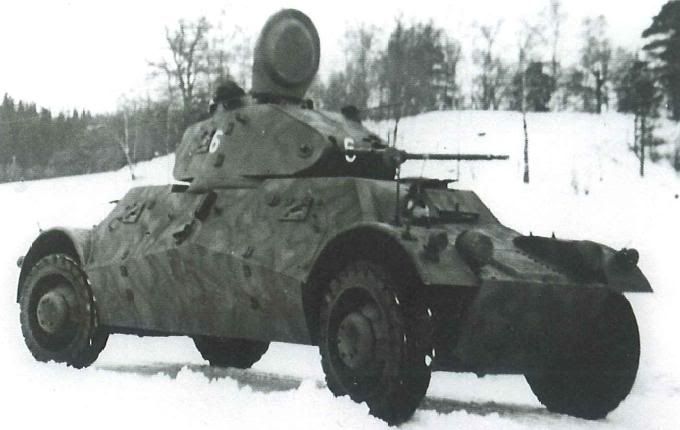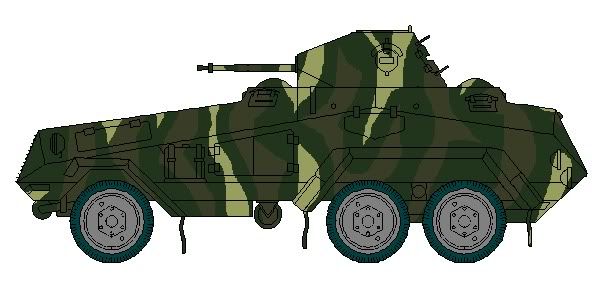January 2
The Irish Army has requested interested manufacturers to submit proposals for armoured cars to modernize the Armoured Car Squadron, replacing older Rolls-Royce armoured cars and Lanchester 6x4s. An order of twenty-eight to thirty-two vehicles will be made. A successful contender shall mount a gun of at least 37mm size (with a British 2-pounder AT gun preferred) with a .30cal or .50cal machine-gun as secondary, have excellent cross-country performance, and a speed of at least 35mph. Frontal armour shall be capable of repelling infantry and light AT rounds (15-20mm). A diesel engine is favored but not required. Maximum weight shall be thirteen tons. [Note 1]
January 19
Leifteanant-Cheannasaí Edward "Eddie" Tiernan and Leifteanant-Cheannasaí Neil Kavanagh have become the second and third officers of the Irish Naval Service to qualify for submarine command by passing the Lough Swilly Submarine School. Cheannasaí Michael Muldoon, who is freshly appointed to command the INS's Submarine Squadron, has not passed the Lough Swilly School but was instead trained by the British Royal Navy.
January 20
"Gentleman," Commander Muldoon said, raising his pint glass. "To the submarine service!"
"Hear hear," the captains replied, answering the toast and draining their glasses.
"So tell me, Boss," asked Ian McGinnes. The submarine officers never addressed their commanding officer by rank unless one of the surface-fleet officers were in earshot - it was always "Boss" or "Little Mike", the latter an unfortunate nickname derived from Muldoon's five-foot-one-inch height. "When are we going to get replacements for these H-boats? I was coming off Waterford the other day and HMS Spearfish came tearing past me at fifteen knots. Beautiful boat - fast, good-looking, modern... We need new boats."
Muldoon smiled. "That we do - and we're going to get 'em sooner than you think. Even the destroyer drivers have started complaining to Commodore O'Muiris that we need better boats - though they say they want to practice on us."
Eddie Tiernan snorted. "Connacht held us down for two hours last week, and Etain gave me a mighty scare at Lough Swilly; but if we get any better boats, the cans are never going to find us!"
"They're getting better," Muldoon said, and the others admitted he was right. "But as I was saying, O'Muiris is talking with Gallagher, Burke and boys to get a new boat laid down by April. And don't," he added hastily, "pass this word around, but the Turks have bought two of the H-boats."
"What?" Kavanagh said, setting down his glass on the table. "Which ones?"
"Pooka and Bradan Feasa," Muldoon answered. "That's actually why we're getting new boats. The Turks wanted 'em all, but the Commodore wants to keep at least three in service at all times. So we're going to build a new Bradan Feasa, quick as we can, and then a few more subs later this year, once we're for sure Gallagher & Burke can put together a sub."
"So what'll we be able to do with the new boats?" McGinnes said.
"The new Bradan Feasa will have a full 3" gun, not that little six-pounder popgun," Muldoon answered. "Twenty-one inch tubes and brand-new eels, fourteen hundred horse Burmeister and Wain diesels, Paxman electric motors - the works. Should make fourteen knots surfaced, eight knots submerged. There's some other stuff I can't tell you boys about yet, too; and you should see what the engineers are drawing up for the ones to follow Bradan Feasa. It'll make her look pretty spartan by comparison!"
January 28
William Butler Yeats has died at the Hôtel Idéal Séjour, in Menton, France.
February 15
The Irish Air Corps has requested specifications for proposals.
- M.1/39: Enclosed-cabin monoplane for military utility use. Aircraft will be used as army reconnaissance and utility aircraft. Successful bid should be cost-effective, simple to operate and maintain, and offer reliable performance and rough-field capabilities. Four seats are preferred; armament is not seen as a requirement. Six aircraft will be acquired before 1941.
- P.1/39: Torpedo-bomber / light bomber to replace Fairey Swordfish. [Note 2] Type will operate as maritime patrol craft, torpedo bomber, and light bomber. Aircraft should have two crewmen (pilot + navigator). Single engine preferred, but twin-engine types will be considered. Armament should be easily interchangeable to permit 18"-21" aerial torpedoes, 500-pound to 1,000-pound bombs (or 4 x 250-pound bombs), or two depth-charges. Speed of 200-300mph and range of over 1,000 miles is preferred. No quantities given. [Note 3]
March 1
The Irish Naval Service has announced the construction of a new submarine, the Bradan Feasa ("Salmon of Knowledge"). The new submarine will be the first submarine built in Ireland and the first submarine built for Ireland.
[Note 1] Specification was written for the AEC armoured car but all entries will be considered.
[Note 2] Somehow, I have this wacky idea of a torpedo-carrying Fairey Fulmar.
[Note 3] If memory serves, the Irish bought the last Swordfish off the production line, and they've been lightly used since then. The Irish are entirely amenable to using them until 1945 or later if nothing interesting shows up.
Quoted
Originally posted by BrockpaineQuoted
Originally posted by BrockpaineQuoted
Originally posted by BrockpaineQuoted
The Irish Army has requested interested manufacturers to submit proposals for armoured cars
Quoted
The Irish Army has requested interested manufacturers to submit proposals for armoured cars ...

